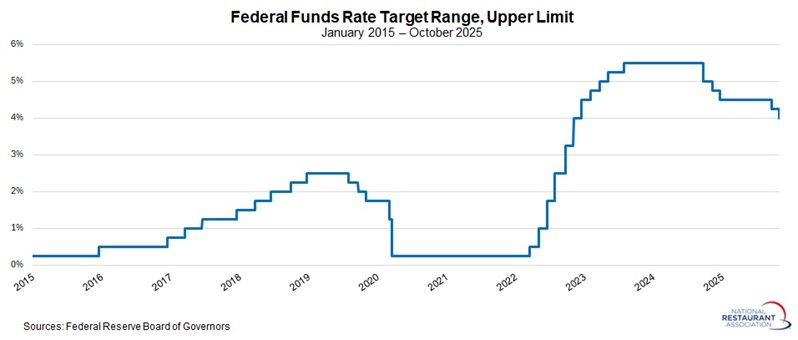Research
October 29, 2025
Monetary Policy
Federal Reserve cuts interest rates for the second time this year
The Federal Open Market Committee (FOMC) lowered short-term interest rates by 25 basis points at its October 28–29 meeting, building on the similar rate cut seen at its September meeting. The new target federal funds range now stands at 3.75 to 4.00 percent.
In addition to cutting interest rates, the FOMC will “conclude the reduction of its aggregate securities holdings on December 1.” The Federal Reserve’s current balance sheet includes roughly $6.6 trillion in total assets, down from a peak of nearly $9.0 trillion in April 2022.
These decisions reflect growing concerns about a cooling labor market. As the FOMC noted, “Job gains have slowed this year, and the unemployment rate has edged up but remained low through August.” The end date in this sentence is an acknowledgment that more current economic data on jobs are unavailable due to the government shutdown.
The Fed continues to proceed cautiously, acknowledging that “inflation has moved up since earlier in the year and remains somewhat elevated.” The statement also observed, “Uncertainty about the economic outlook remains elevated.”
Overall, the FOMC reaffirmed its commitment to its dual mandate of maximum employment and 2% inflation. Policymakers emphasized that future rate decisions will be data-dependent, with a continued focus on achieving greater policy clarity.
There were two dissents. One was from Stephen I. Miran, the newest member of the Federal Reserve Board of Governors, who advocated for a more aggressive 50 basis point cut to a range of 3.50 to 3.75 percent. At the same time, Kansas City Federal Reserve Bank President Jeffrey R. Schmidt would have preferred for no rate cut at this meeting.
The Federal Reserve is widely expected to reduce short-term rates one more time this year—at its upcoming December 9–10 meeting. Yet, Chairman Jerome H. Powell downplayed the inevitability of a December rate cut, saying in his press conference that such a move was not a "forgone conclusion." The next FOMC move will likely hinge on incoming data, particularly once the government shutdown ends.
For the restaurant industry, elevated interest rates continue to weigh on borrowing costs, delaying expansion plans and capital investments. A lower rate environment could help ease credit burdens, bolster consumer spending, and support demand in sectors sensitive to discretionary income, including for foodservice and hospitality.

In addition to cutting interest rates, the FOMC will “conclude the reduction of its aggregate securities holdings on December 1.” The Federal Reserve’s current balance sheet includes roughly $6.6 trillion in total assets, down from a peak of nearly $9.0 trillion in April 2022.
These decisions reflect growing concerns about a cooling labor market. As the FOMC noted, “Job gains have slowed this year, and the unemployment rate has edged up but remained low through August.” The end date in this sentence is an acknowledgment that more current economic data on jobs are unavailable due to the government shutdown.
The Fed continues to proceed cautiously, acknowledging that “inflation has moved up since earlier in the year and remains somewhat elevated.” The statement also observed, “Uncertainty about the economic outlook remains elevated.”
Overall, the FOMC reaffirmed its commitment to its dual mandate of maximum employment and 2% inflation. Policymakers emphasized that future rate decisions will be data-dependent, with a continued focus on achieving greater policy clarity.
There were two dissents. One was from Stephen I. Miran, the newest member of the Federal Reserve Board of Governors, who advocated for a more aggressive 50 basis point cut to a range of 3.50 to 3.75 percent. At the same time, Kansas City Federal Reserve Bank President Jeffrey R. Schmidt would have preferred for no rate cut at this meeting.
The Federal Reserve is widely expected to reduce short-term rates one more time this year—at its upcoming December 9–10 meeting. Yet, Chairman Jerome H. Powell downplayed the inevitability of a December rate cut, saying in his press conference that such a move was not a "forgone conclusion." The next FOMC move will likely hinge on incoming data, particularly once the government shutdown ends.
For the restaurant industry, elevated interest rates continue to weigh on borrowing costs, delaying expansion plans and capital investments. A lower rate environment could help ease credit burdens, bolster consumer spending, and support demand in sectors sensitive to discretionary income, including for foodservice and hospitality.
